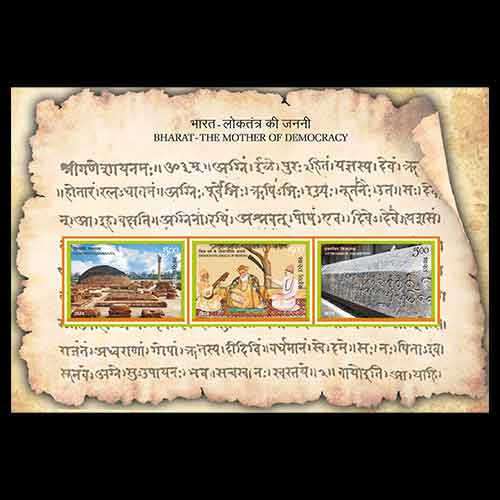Fascinating Archaeological Facts on Postage Stamps - 90
2025-08-23 Sat
Uthiramerur, a Village in Kanchipuram, Tamil Nadu, is notable for its Temple inscriptions that describe a self-governance system in 10th century CE. According to the e-PG Pathshala developed by the Ministry of human Resource Development (MHRD), the historical origins of the village can be traced back to the Iron Age, as evidenced by megalithic burials found in the region.The village is home to nearly a hundred inscriptions sourced from various temples, with the earliest inscription attributed to Pallava Nandivarman II (731 CE – c.?796 CE). This inscription outlines the operational Framework of the Local sabha, or village assembly, which was comprised predominantly of Brahmin members known as Perunkuri Perumakkal, or elders of the assembly.
While many inscriptions from the Pallava and Chola periods in Tamil Nadu discuss the functions of village assemblies, the most notable inscription originates from the reign of Parantaka I (907-953 CE) and is located on the walls of the Vaikunda Perumal Temple. Written in Tamil, the inscription incorporates a blend of Sanskrit terminology and utilizes both Tamil and Grantha scripts. It provides critical insights into the electoral Systems, qualifications and disqualifications of members, and the functions of local bodies within the village assembly during the 10th century CE. This represents the earliest documented instance of local self-governance through a democratic framework known in the historical context of electoral systems worldwide.
Additionally, the inscription mentions that in the 12th regnal year of Parantaka I, the village elders gathered at the temple mandapa, where they enacted resolutions concerning the Kudavolai electoral system, also referred to as the Pot-ticket system, for appointing members to specific village committees. In this system, the term "Kudam" translates to "pot," and "Olai" to "palm leaf." Contestants' names for the ‘Maha Sabhas’ were inscribed on palm leaves, and the selection of the winner was determined by a chance drawing, conducted publicly by a Brahmin boy.
Furthermore, the village was systematically organized into 30 wards, with one representative elected to serve each ward. Eligibility for candidacy was restricted to individuals aged between 35 and 70 years who owned taxable land. Additionally, candidates were required to possess a legally constructed house. Those serving on any committee were barred from contesting for election in the subsequent three terms, each lasting one year. Elected officials who engaged in bribery, misappropriated #property, committed incest, or acted contrary to the public interest faced disqualification.
On 25 January 2024, in celebration of the 75th Republic Day, India Post issued a miniature Sheet titled 'Bharat – The Mother of Democracy,' dedicated to honoring the concept of democracy. Among the featured images was the Uthiramerur inscription, highlighting its enduring significance in the narrative of democratic Governance.
Latest News
-
Antiochos I Soter Silver Tetradrachm, weighing 16.87 grams, sold for INR 22,000.
2025-10-07 TueAntiochos I, the Greek king of the Seleucid Empire, was of mixed heritage, being half-Iranian and ha...
-
Ghiyath Shah as Heir Apparent
2025-09-25 ThuGhiyath Shah was the ruler of the Malwa Sultanate, reigning from 1456 to 1500. From 1456 to 1469, he...
-
Malwa Sultan Mahmud Shah Silver Coins
2025-09-11 ThuMalwa Sultan Mahmud Shah minted silver coins in round and square flans. <br><br> For round coins,...
-
Malwa Sultan Mahmud Shah Billon coin
2025-08-26 TueMalwa Sultan Mahmud Shah's billon coins followed three weight standards: 100 rati, 96 rati, and 80 r...
-
Fascinating Archaeological Facts on Postage Stamps - 91
2025-08-23 SatRhinoceros is one of the oldest land mammal species existing in India. There are five species of rhi...

